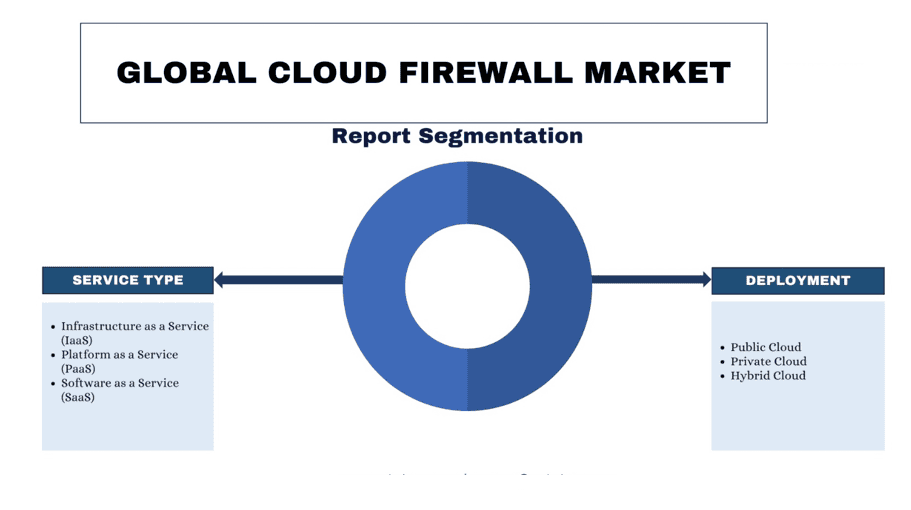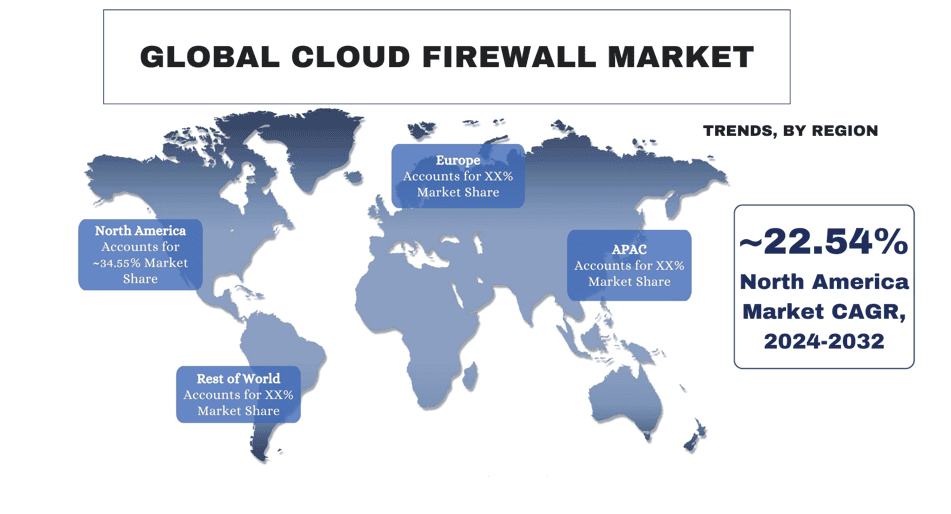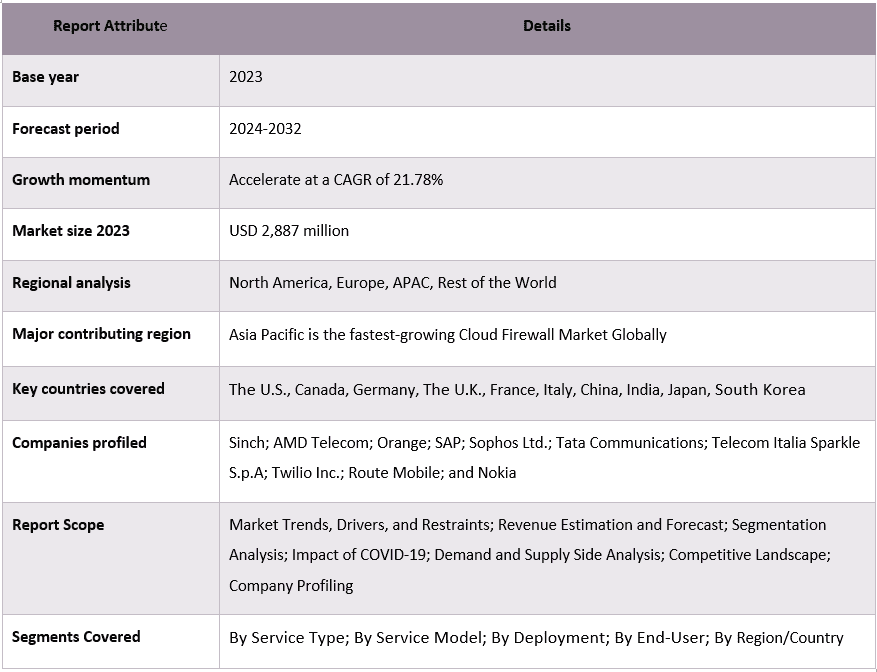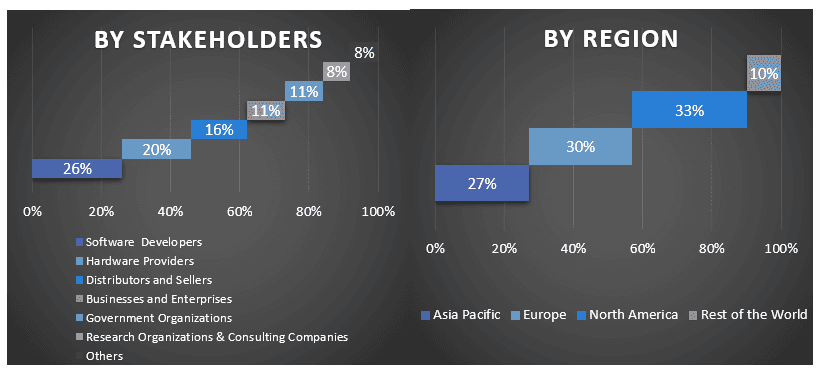- Trang chủ
- Về chúng tôi
- Ngành
- Dịch vụ
- Đọc
- Liên hệ với chúng tôi
Thị trường Tường lửa Đám mây: Phân tích Hiện tại và Dự báo (2024-2032)
Tập trung vào Loại Dịch vụ (Giám sát và Kiểm soát Lưu lượng, Quản lý Tuân thủ và Kiểm toán, Báo cáo và Quản lý Nhật ký, Tự động hóa và Điều phối, Quản lý Bảo mật, Dịch vụ Được quản lý, Dịch vụ Chuyên nghiệp và Các dịch vụ khác); Mô hình Dịch vụ (Cơ sở hạ tầng như một Dịch vụ (IaaS), Nền tảng như một Dịch vụ (PaaS) và Phần mềm như một Dịch vụ (SaaS)); Triển khai (Đám mây Công cộng, Đám mây Riêng tư và Đám mây Lai); Người dùng Cuối (CNTT & Viễn thông, BFSI, Chính phủ và Khu vực Công cộng, Chăm sóc Sức khỏe và Khoa học, Sản xuất, Bán lẻ và Thương mại Điện tử, và Năng lượng và Tiện ích); và Khu vực/Quốc gia

Quy mô & Dự báo Thị trường Tường lửa Đám mây
Thị trường tường lửa đám mây được định giá 2.887 triệu USD và dự kiến sẽ tăng trưởng với CAGR mạnh mẽ khoảng 21,78% trong giai đoạn dự báo (2024-2032) do các mối đe dọa an ninh mạng ngày càng tăng.
Phân tích Thị trường Tường lửa Đám mây
Tường lửa Đám mây là một giải pháp tường lửa dựa trên đám mây giúp đơn giản hóa cơ sở hạ tầng CNTT cho các công ty. Nó cung cấp các khả năng tường lửa thế hệ tiếp theo như lọc web, bảo vệ chống lại các mối đe dọa nâng cao, hệ thống ngăn chặn xâm nhập và bảo mật Hệ thống Tên miền. Về bản chất, tường lửa đám mây cung cấp khả năng bảo vệ tường lửa thông qua mô hình dịch vụ dựa trên đám mây, mang lại cho các công ty những lợi ích về bảo mật mà không cần phần cứng vật lý tại chỗ. Dịch vụ này được thiết kế để tăng cường bảo mật mạng bằng cách giám sát và kiểm soát lưu lượng dữ liệu đến và đi dựa trên các quy tắc bảo mật đã được thiết lập, giúp ngăn chặn truy cập trái phép và bảo vệ chống lại các mối đe dọa tiềm ẩn.
Sự gia tăng của điện toán đám mây đã dẫn đến một sự thay đổi mô hình trong cách các doanh nghiệp vận hành và quản lý cơ sở hạ tầng CNTT của họ. Tường lửa Đám mây cung cấp khả năng tích hợp liền mạch với nhiều nền tảng đám mây khác nhau, đảm bảo các chính sách bảo mật nhất quán trên các môi trường đám mây lai và đa đám mây. Hơn nữa, đại dịch COVID-19 đã thúc đẩy việc áp dụng làm việc từ xa. Với việc nhân viên truy cập tài nguyên của công ty từ nhiều thiết bị và địa điểm, các tường lửa tại chỗ truyền thống phải vật lộn để cung cấp khả năng bảo vệ toàn diện. Tường lửa Đám mây cung cấp một giải pháp bảo mật tập trung có thể thực thi các chính sách nhất quán và bảo vệ nhân viên từ xa, bất kể vị trí hoặc thiết bị của họ. Ngoài ra, trong bối cảnh kinh doanh phát triển nhanh chóng ngày nay, các tổ chức yêu cầu sự linh hoạt và khả năng mở rộng quy mô hoạt động của họ một cách nhanh chóng. Các giải pháp Tường lửa Đám mây cung cấp khả năng mở rộng quy mô theo yêu cầu, cho phép các doanh nghiệp dễ dàng điều chỉnh tài nguyên bảo mật của họ dựa trên các yêu cầu thay đổi. Hơn nữa, ngành công nghiệp an ninh mạng đang phải đối mặt với tình trạng thiếu hụt đáng kể các chuyên gia lành nghề, gây khó khăn cho các tổ chức trong việc xây dựng và duy trì các nhóm bảo mật nội bộ.Ví dụ: theo Nghiên cứu Lực lượng Lao động An ninh Mạng (ISC)² năm 2022, khoảng cách lực lượng lao động an ninh mạng toàn cầu đã tăng lên 3,4 triệu, tăng từ 2,7 triệu vào năm 2021. Những phát triển này cùng với những phát triển khác đang thúc đẩy một môi trường thuận lợi, ảnh hưởng đến việc áp dụng rộng rãi tường lửa đám mây trong các ngành công nghiệp khác nhau.
Xu hướng Thị trường Tường lửa Đám mây
Phần này thảo luận về các xu hướng thị trường chính đang ảnh hưởng đến các phân khúc khác nhau của Thị trường Tường lửa Đám mây như được xác định bởi nhóm các chuyên gia nghiên cứu của chúng tôi.

Lĩnh vực Ngân hàng, Tài chính & Bảo hiểm (BFSI) nổi bật là một phân khúc người dùng cuối chính cho Ngành Tường lửa Đám mây trên toàn thế giới.
Lĩnh vực Ngân hàng, Dịch vụ Tài chính và Bảo hiểm (BFSI) là người dùng cuối chính cho tường lửa đám mây trên thị trường toàn cầu. Ngành BFSI phải tuân theo các quy định và yêu cầu tuân thủ nghiêm ngặt để bảo vệ dữ liệu tài chính và giao dịch nhạy cảm. Tường lửa đóng một vai trò quan trọng trong việc đáp ứng các tiêu chuẩn quy định này. Hơn nữa, các tổ chức tài chính xử lý một lượng lớn dữ liệu nhạy cảm và các giao dịch tiền tệ, khiến chúng trở thành mục tiêu hấp dẫn cho tội phạm mạng. Tường lửa mạng đóng vai trò là tuyến phòng thủ đầu tiên chống lại các mối đe dọa mạng khác nhau. Hơn nữa, lĩnh vực BFSI được coi là cơ sở hạ tầng quan trọng và bất kỳ sự gián đoạn hoặc vi phạm nào có thể gây ra hậu quả nghiêm trọng cho nền kinh tế và sự tin tưởng của công chúng. Tường lửa mạng giúp bảo vệ cơ sở hạ tầng quan trọng này bằng cách kiểm soát và giám sát lưu lượng mạng. Ngoài ra, ngành BFSI đang trải qua quá trình chuyển đổi kỹ thuật số nhanh chóng, với việc áp dụng ngân hàng trực tuyến, ứng dụng di động và dịch vụ dựa trên đám mây. Khi các kênh kỹ thuật số này mở rộng, bề mặt tấn công cũng tăng lên, đòi hỏi bảo mật mạng mạnh mẽ. Các yếu tố như vậy đã khiến ngành BFSI trở thành một phân khúc người dùng cuối chính cho tường lửa đám mây trên toàn thế giới.
Bắc Mỹ nổi lên là Thị trường lớn nhất cho Tường lửa Đám mây trên toàn thế giới.
Trong khu vực Bắc Mỹ, Hợp chủng quốc Hoa Kỳ nắm giữ phần lớn thị trường Tường lửa Đám mây của Bắc Mỹ. Yếu tố chính thúc đẩy sự tăng trưởng của thị trường là vị trí dẫn đầu trong ngành công nghệ trên toàn cầu. Hơn nữa, Hợp chủng quốc Hoa Kỳ là nơi tập trung của một số ngân hàng lớn nhất trên thế giới, thúc đẩy nhu cầu về cơ sở hạ tầng tường lửa bảo mật mạnh mẽ.
Bắc Mỹ, đặc biệt là Hoa Kỳ, là một trung tâm cho sự đổi mới công nghệ và các giải pháp an ninh mạng tiên tiến. Hơn nữa, Bắc Mỹ tự hào có một nền kinh tế mạnh mẽ với một số lượng đáng kể các doanh nghiệp và doanh nghiệp lớn trong các ngành công nghiệp khác nhau. Các tổ chức này có ngân sách CNTT đáng kể được phân bổ cho an ninh mạng, bao gồm đầu tư vào tường lửa bảo mật mạng để giảm thiểu rủi ro một cách hiệu quả. Hơn nữa, Hoa Kỳ, với một trong những dân số kỹ thuật số lớn nhất trên toàn cầu, chứng kiến một số lượng đáng kể các cuộc tấn công mạng hàng năm. Theo một cuộc khảo sát được thực hiện vào năm 2021, khoảng 60% người dùng trực tuyến ở quốc gia này đã gặp phải một số hình thức tấn công mạng, đưa quốc gia này trở thành quốc gia cao thứ ba về tỷ lệ tội phạm mạng. Trong năm báo cáo gần đây nhất, các sự cố vi phạm dữ liệu đã ảnh hưởng đến khoảng 294 triệu người dùng internet ở Hoa Kỳ. Trong số các loại tấn công mạng khác nhau, xâm nhập mạng nổi lên là phổ biến nhất trên toàn quốc, thúc đẩy chính phủ tăng cường đầu tư vào chiến lược an ninh mạng, mang lại lợi ích cho nhà cung cấp tường lửa đám mây. Ví dụ: Trong năm tài chính 2024, DHS đã phân bổ hơn 3 tỷ đô la Mỹ cho an ninh mạng, khiến nó trở thành cơ quan được tài trợ hàng đầu trong số các cơ quan chính phủ theo đạo luật CFO, ngoại trừ DoD. Tổng chi tiêu cho an ninh mạng ở Hoa Kỳ đã tăng lên vào năm 2023, với tổng số tiền tài trợ của cơ quan ước tính là 10,46 tỷ đô la Mỹ.
Tổng quan về Ngành Tường lửa Đám mây
Thị trường tường lửa đám mây mang tính cạnh tranh và phân mảnh, với sự hiện diện của một số công ty tham gia thị trường toàn cầu và quốc tế. Các công ty chủ chốt đang áp dụng các chiến lược tăng trưởng khác nhau để tăng cường sự hiện diện trên thị trường của họ, chẳng hạn như quan hệ đối tác, thỏa thuận, hợp tác, ra mắt sản phẩm mới, mở rộng địa lý và sáp nhập và mua lại. Một số công ty lớn đang hoạt động trên thị trường là Sinch; AMD Telecom; Orange; SAP; Sophos Ltd.; Tata Communications; Telecom Italia Sparkle S.p.A; Twilio Inc.; Route Mobile; và Nokia.

Tin tức Thị trường Tường lửa Đám mây
- Vào tháng 1 năm 2024, Zscaler Inc. đã ra mắt Zscaler Zero Trust SASE, một giải pháp edge dịch vụ truy cập an toàn hoàn chỉnh và giải pháp Zero Trust SD-WAN của họ. Các giải pháp này được xây dựng trên kiến trúc zero-trust, ưu tiên xác minh tất cả các kết nối với hệ thống thay vì mù quáng tin tưởng bất cứ điều gì bên trong hoặc bên ngoài chu vi của tổ chức.
- Vào tháng 1 năm 2024, theo báo cáo do Diễn đàn Kinh tế Thế giới (WEF) công bố, 29% tổ chức báo cáo rằng họ đã bị ảnh hưởng nghiêm trọng bởi một sự cố mạng trong 12 tháng qua và 41% tổ chức bị ảnh hưởng nghiêm trọng trong 12 tháng qua báo cáo rằng nó là do một bên thứ ba gây ra, đòi hỏi nhu cầu về tường lửa bảo mật trên các ngành công nghiệp khác nhau.
Phạm vi Báo cáo Thị trường Tường lửa Đám mây

Lý do nên mua báo cáo này:
- Nghiên cứu bao gồm phân tích kích thước thị trường và dự báo được xác thực bởi các chuyên gia ngành công nghiệp chính được xác thực.
- Báo cáo trình bày một đánh giá nhanh về hiệu suất tổng thể của ngành trong nháy mắt.
- Báo cáo bao gồm một phân tích chuyên sâu về các đồng nghiệp ngành nổi bật với trọng tâm chính vào các tài chính kinh doanh chính, danh mục sản phẩm, chiến lược mở rộng và các phát triển gần đây.
- Kiểm tra chi tiết các yếu tố thúc đẩy, hạn chế, xu hướng chính và cơ hội thịnh hành trong ngành.
- Nghiên cứu bao gồm toàn diện thị trường trên các phân khúc khác nhau.
- Phân tích sâu cấp khu vực của ngành.
Tùy chọn tùy chỉnh:
Thị trường Tường lửa Đám mây toàn cầu có thể được tùy chỉnh thêm theo yêu cầu hoặc bất kỳ phân khúc thị trường nào khác. Bên cạnh đó, UMI hiểu rằng bạn có thể có nhu cầu kinh doanh riêng, vì vậy hãy liên hệ với chúng tôi để có được một báo cáo hoàn toàn phù hợp với yêu cầu của bạn.
Mục lục
Phương pháp Nghiên cứu cho Phân tích Thị trường Tường lửa Đám mây (2024-2032)
Phân tích thị trường lịch sử, ước tính thị trường hiện tại và dự báo thị trường tương lai của thị trường Tường lửa Đám mây toàn cầu là ba bước chính được thực hiện để tạo và phân tích việc áp dụng Tường lửa Đám mây ở các khu vực chính trên toàn cầu. Nghiên cứu thứ cấp toàn diện đã được thực hiện để thu thập các số liệu thị trường lịch sử và ước tính quy mô thị trường hiện tại. Thứ hai, để xác thực những hiểu biết sâu sắc này, nhiều phát hiện và giả định đã được xem xét. Hơn nữa, các cuộc phỏng vấn sơ cấp toàn diện cũng đã được thực hiện, với các chuyên gia trong ngành trên toàn bộ chuỗi giá trị của thị trường Tường lửa Đám mây toàn cầu. Sau giả định và xác thực các số liệu thị trường thông qua các cuộc phỏng vấn sơ cấp, chúng tôi đã sử dụng phương pháp tiếp cận từ trên xuống/từ dưới lên để dự báo quy mô thị trường hoàn chỉnh. Sau đó, các phương pháp phân tích thị trường và phân tích dữ liệu đã được áp dụng để ước tính và phân tích quy mô thị trường của các phân khúc và phân khúc con của ngành liên quan đến. Phương pháp chi tiết được giải thích dưới đây:
Phân tích Quy mô Thị trường Lịch sử
Bước 1: Nghiên cứu Chuyên sâu về Các Nguồn Thứ cấp:
Một nghiên cứu thứ cấp chi tiết đã được thực hiện để có được quy mô thị trường lịch sử của thị trường Tường lửa Đám mây thông qua các nguồn nội bộ của công ty nhưbáo cáo thường niên & báo cáo tài chính, thuyết trình hiệu suất, thông cáo báo chí, v.v.và các nguồn bên ngoài bao gồmtạp chí, tin tức & bài viết, ấn phẩm của chính phủ, ấn phẩm của đối thủ cạnh tranh, báo cáo ngành, cơ sở dữ liệu của bên thứ ba và các ấn phẩm đáng tin cậy khác.
Bước 2: Phân khúc Thị trường:
Sau khi có được quy mô thị trường lịch sử của thị trường Tường lửa Đám mây, chúng tôi đã tiến hành phân tích thứ cấp chi tiết để thu thập thông tin chi tiết về thị trường lịch sử và chia sẻ cho các phân khúc & phân khúc con khác nhau cho các khu vực chính. Các phân khúc chính được bao gồm trong báo cáo như loại dịch vụ, mô hình dịch vụ, triển khai và người dùng cuối. Phân tích cấp quốc gia hơn nữa đã được thực hiện để đánh giá việc áp dụng tổng thể các mô hình kiểm tra ở khu vực đó.
Bước 3: Phân tích Yếu tố:
Sau khi có được quy mô thị trường lịch sử của các phân khúc và phân khúc con khác nhau, chúng tôi đã tiến hành một nghiên cứu chi tiếtphân tích yếu tốđể ước tính quy mô thị trường hiện tại của thị trường Cloud Firewall. Hơn nữa, chúng tôi đã tiến hành phân tích nhân tố bằng cách sử dụng các biến phụ thuộc và độc lập như loại dịch vụ, mô hình dịch vụ, triển khai và người dùng cuối của thị trường Cloud Firewall. Một phân tích kỹ lưỡng đã được thực hiện về các tình huống cung và cầu, xem xét các quan hệ đối tác hàng đầu, sáp nhập và mua lại, mở rộng kinh doanh và ra mắt sản phẩm trong lĩnh vực thị trường Cloud Firewall trên toàn cầu.
Ước tính & Dự báo Quy mô Thị trường Hiện tại
Ước tính Quy mô Thị trường Hiện tại:Dựa trên những hiểu biết sâu sắc có thể hành động từ 3 bước trên, chúng tôi đã đi đến quy mô thị trường hiện tại, các nhân tố chính trên thị trường Cloud Firewall toàn cầu và thị phần của các phân khúc. Tất cả các phân chia tỷ lệ phần trăm và phân tích thị trường cần thiết đã được xác định bằng cách sử dụng phương pháp thứ cấp đã đề cập ở trên và được xác minh thông qua các cuộc phỏng vấn chính.
Ước tính & Dự báo:Để ước tính và dự báo thị trường, trọng số đã được gán cho các yếu tố khác nhau bao gồm động lực & xu hướng, hạn chế và cơ hội dành cho các bên liên quan. Sau khi phân tích các yếu tố này, các kỹ thuật dự báo có liên quan, tức là phương pháp top-down/bottom-up, đã được áp dụng để đưa ra dự báo thị trường cho năm 2032 cho các phân khúc và phân khúc phụ khác nhau trên các thị trường lớn trên toàn cầu. Phương pháp nghiên cứu được áp dụng để ước tính quy mô thị trường bao gồm:
- Quy mô thị trường của ngành, tính theo doanh thu (USD) và tỷ lệ ứng dụng của thị trường Cloud Firewall trên các thị trường lớn trong nước
- Tất cả các tỷ lệ phần trăm, phân chia và phân tích của các phân khúc và phân khúc phụ của thị trường
- Các nhân tố chính trên thị trường Cloud Firewall toàn cầu về các sản phẩm được cung cấp. Ngoài ra, các chiến lược tăng trưởng được các nhân tố này áp dụng để cạnh tranh trong thị trường đang phát triển nhanh chóng.
Xác nhận Quy mô và Chia sẻ Thị trường
Nghiên cứu Sơ cấp:Các cuộc phỏng vấn chuyên sâu đã được tiến hành với các Nhà lãnh đạo Ý kiến Chính (KOL) bao gồm các Giám đốc Điều hành Cấp cao (CXO/VPs, Trưởng phòng Bán hàng, Trưởng phòng Marketing, Trưởng phòng Vận hành, Trưởng phòng Khu vực, Trưởng phòng Quốc gia, v.v.) trên các khu vực chính. Các phát hiện nghiên cứu sơ cấp sau đó đã được tóm tắt và phân tích thống kê đã được thực hiện để chứng minh giả thuyết đã nêu. Đầu vào từ nghiên cứu sơ cấp đã được hợp nhất với các phát hiện thứ cấp, do đó biến thông tin thành những hiểu biết sâu sắc có thể hành động.
Phân chia những người tham gia chính ở các khu vực khác nhau

Kỹ thuật Thị trường
Kỹ thuật tam giác dữ liệu đã được sử dụng để hoàn thành việc ước tính thị trường tổng thể và đưa ra các con số thống kê chính xác cho từng phân khúc và phân khúc phụ của thị trường Cloud Firewall toàn cầu. Dữ liệu đã được chia thành một số phân khúc & phân khúc phụ sau khi nghiên cứu các thông số và xu hướng khác nhau trong các lĩnh vực loại hình dịch vụ, mô hình dịch vụ, triển khai và người dùng cuối trong thị trường Cloud Firewall toàn cầu.
Mục tiêu chính của Nghiên cứu Thị trường Cloud Firewall Toàn cầu
Các xu hướng thị trường hiện tại & tương lai của thị trường Cloud Firewall toàn cầu đã được xác định trong nghiên cứu. Các nhà đầu tư có thể có được những hiểu biết chiến lược để đưa ra quyết định đầu tư của họ dựa trên phân tích định tính và định lượng được thực hiện trong nghiên cứu. Các xu hướng thị trường hiện tại và tương lai xác định sức hấp dẫn tổng thể của thị trường ở cấp độ khu vực, cung cấp một nền tảng để người tham gia công nghiệp khai thác thị trường chưa được khai thác để hưởng lợi từ lợi thế đi đầu. Các mục tiêu định lượng khác của các nghiên cứu bao gồm:
- Phân tích quy mô thị trường hiện tại và dự báo của thị trường Cloud Firewall tính theo giá trị (USD). Ngoài ra, hãy phân tích quy mô thị trường hiện tại và dự báo của các phân khúc và phân khúc phụ khác nhau.
- Các phân khúc trong nghiên cứu bao gồm các lĩnh vực loại hình dịch vụ, mô hình dịch vụ, triển khai và người dùng cuối.
- Xác định và phân tích khuôn khổ pháp lý cho Cloud Firewall
- Phân tích chuỗi giá trị liên quan đến sự hiện diện của các trung gian khác nhau, cùng với việc phân tích hành vi của khách hàng và đối thủ cạnh tranh của ngành
- Phân tích quy mô thị trường hiện tại và dự báo của thị trường Cloud Firewall cho khu vực chính
- Các quốc gia chính của các khu vực được nghiên cứu trong báo cáo bao gồm Châu Á Thái Bình Dương, Châu Âu, Bắc Mỹ và Phần còn lại của Thế giới
- Hồ sơ công ty của thị trường Cloud Firewall và các chiến lược tăng trưởng được những người tham gia thị trường áp dụng để duy trì trong thị trường đang phát triển nhanh chóng.
- Phân tích chuyên sâu cấp độ khu vực của ngành
Câu hỏi thường gặp Câu hỏi thường gặp
Q1: Quy mô thị trường hiện tại và tiềm năng tăng trưởng của thị trường Tường lửa Đám mây toàn cầu là gì?
Q2: Những yếu tố nào thúc đẩy sự tăng trưởng của Thị trường Tường lửa Đám mây toàn cầu?
Q3: Phân khúc nào chiếm phần lớn thị trường Tường lửa Đám mây toàn cầu theo Người dùng cuối?
Q4: Các công nghệ và xu hướng mới nổi nào trên thị trường Tường lửa Đám mây toàn cầu?
Q5: Khu vực nào sẽ là thị trường Tường lửa Đám mây toàn cầu phát triển nhanh nhất?
Q6: Ai là những người chơi chủ chốt trên thị trường Tường lửa Đám mây toàn cầu?
Liên quan Báo cáo
Khách hàng đã mua mặt hàng này cũng đã mua










